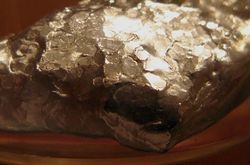- Wood's metal
-
Wood's metal, also known as Lipowitz's alloy or by the commercial names cerrobend, bendalloy, pewtalloy or MCP 158, is a eutectic, fusible alloy with a melting point of approximately 70 °C (158 °F). It is a eutectic alloy of 50% bismuth, 26.7% lead, 13.3% tin, and 10% cadmium by weight.[1] It is named after American metallurgist B. Wood.
Contents
Applications
Wood's metal is useful as a low-melting solder, low-temperature casting metal, high temperature coupling fluid in heat baths, and as a fire-melted valve element in fire sprinkler systems in buildings. Medical gas cylinders in the United Kingdom have a Wood's metal seal which melts in fire, allowing the gas to escape and reducing the risk of gas explosion.
A common use is as a filler when bending thin-walled metal tubes. For this use the tubing is filled with molten Wood's metal. After the filler solidifies the tubing is bent, and the filler prevents collapse of the tubing. The Wood's metal is then removed by heating, often by boiling in water.
Other uses include making custom-shaped apertures and blocks (for example, electron-beam cutouts and lung blocks) for medical radiation treatment, and making metal inlays in wood.
Wood's metal is also useful for repairing antiques. For example, a bent piece of sheet metal may be repaired by casting a Wood's metal die from a good example. The low melting temperature of Wood's metal makes it unlikely this will harm the original. The damaged piece can then be clamped in the die and slowly tightened to form it back into shape.
Wood's metal has long been used by model railroad enthusiasts to add weight to locomotives, increasing traction, and the number of cars that can be pulled.
Wood's metal is also used in the making of extracellular electrode for the electro-physiological recording of neural activity.[2]
Like other fusible alloys, e.g. Rose's metal, Wood's metal can be used as a heat transfer medium in hot baths. Hot baths with Rose's and Wood's metals are not in routine use but are employed for temperatures above 220 °C.[3]
Toxicity
Wood's metal is toxic because it contains lead and cadmium, and therefore contact with the bare skin is thought to be harmful, especially in the molten state. Vapour from cadmium-containing alloys is also known to pose a danger to humans. Cadmium poisoning carries the risk of cancer, anosmia (loss of sense of smell), and damage to the liver, kidneys, nerves, bones, and respiratory system. Field's metal is a non-toxic alternative.
The dust may form flammable mixtures with air.
Related alloys
A similar alloy is called cerrosafe. This non-eutectic alloy melts at 165 °F (74 °C). It is mainly used by gunsmiths for making a reference casting of the chamber of a firearm. When it solidifies it first shrinks, allowing easy removal from the chamber. When it cools it expands back to the exact size of the chamber. The casting can then be directly measured with calipers or a micrometer to determine the dimension of the weapon's chamber, which is important for safety.
Their compositions are as follows:
Alloy Melting point Eutectic? Bismuth Lead Tin Indium Cadmium Thallium Rose's metal 98 °C (208 °F) no 50% 25 % 25% – – – Cerrosafe 74 °C (165 °F) no 49% 37.7% 11.3% – 8.5% – Wood's metal 70 °C (158 °F) yes 50% 26.7% 13.3% – 10% – Field's metal 62 °C (144 °F) yes 32.5% – 16.5% 51% – – Cerrolow 136 58 °C (136 °F) yes 49% 18% 12% 21% – – Cerrolow 117 47.2 °C (117 °F) yes 44.7% 22.6% 8.3% 19.1% 5.3% – Bi-Pb-Sn-Cd-In-Tl 41.5 °C (107 °F) yes 40.3 % 22.2% 10.7% 17.7 % 8.1% 1.1 % References
- ^ "Gardner's Chemical Synonyms and Trade Names". John Wiley & Sons. http://www.wiley.com/WileyCDA/WileyTitle/productCd-0566081903.html.
- ^ Frank K, and Becker MC. Microelectrodes for recording and stimulation. In: Physical techniques in biological research, edited by Nastuk WL. New York: Academic Press, 1964, p. 23-84.
- ^ http://books.google.com/books?id=m-hibT7AaK8C&pg=PA135&dq=rose's+metal&lr=&num=50&as_brr=3&cd=22#v=onepage&q=rose's%20metal&f=false
Bibliography
- Birchon's Dictionary of Metallurgy, London, 1965
- Experimental techniques in low-temperature physics, G. K. White, Oxford University Press, Third Edition
External links
- Making your own low-melting point eutectic: Science Toys: A metal that melts in hot water
- Examples of chamber casts using low-temp metal
Categories:- Fusible alloys
Wikimedia Foundation. 2010.

